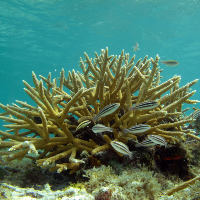Distribution, abundance, and health indicators of the critically endangered coral species Acropora cervicornis in Los Roques National Park, 2014

Accepted: 9 February 2022
Supplementary Materials: 0
HTML: 15
All claims expressed in this article are solely those of the authors and do not necessarily represent those of their affiliated organizations, or those of the publisher, the editors and the reviewers. Any product that may be evaluated in this article or claim that may be made by its manufacturer is not guaranteed or endorsed by the publisher.
Authors
Acropora cervicornis is one of the most important coral species in shallow reefs of the Caribbean as it provides habitat and structural complexity to several species of invertebrates and fish. However, the distribution range of A. cervicornis has shrunk and collapsed considerably during the last five decades, due to a combination of factors including the increase of disease prevalence, storm frequency, and anthropogenic threats. Despite being classed as “Critically Endangered” in the IUCN Red List, information regarding its population status and condition across large Caribbean coralline areas is limited. Herein we conducted the first Marine Protected Area (MPA) scale survey for this species at the Los Roques archipelago, which included visual census across 127 sites to determine the abundance, spatial distribution, habitat type (i.e., leeward, windward), and patch morphology of A. cervicornis (i.e., continuous, dispersed, scatter, isolated). We selected 11 sites, where this species was predicted and reported to be ubiquitous, to determine live A. cervicornis cover, its recent and old mortality cover, and white band disease prevalence as proxies for coral health. For this, four 25-m long photomosaics were analysed at each site. We found Acropora cervicornis in only 29% of the surveyed sites; indicating that this species currently has a narrow and very restricted distribution in Los Roques and suggesting that either this species is rare or has declined over the past decades within the MPA. Dispersed and scattered patches prevailed upon continuous patches, which only occurred in two of the surveyed sites. Moreover, these patches were located near the largest human population settlements, and inside the low protection zones of the MPA where fishing and touristic activities are permitted. The photomosaic survey showed that more than 75% A. cervicornis patches showed an average live cover above 27%, low prevalence of white band disease (<7%), and low macroalgal abundance (<10%); suggesting that Los Roques still holds healthy populations. Our results indicate that the persistence of this species urgently requires re-evaluating current MPA zoning, especially following recent evidence of overfishing and inadequate law enforcement. This study provides a baseline of A. cervicornis populations in Los Roques and Southern Caribbean that can be later used for local population management and conservation.
How to Cite
PAGEPress has chosen to apply the Creative Commons Attribution NonCommercial 4.0 International License (CC BY-NC 4.0) to all manuscripts to be published.


 https://doi.org/10.4081/aiol.2021.10005
https://doi.org/10.4081/aiol.2021.10005



